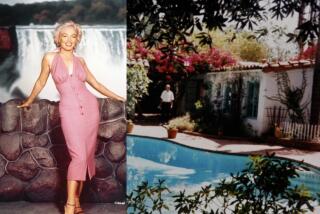Panel Wants Bowling Alley Preserved
The Holiday Bowl, a kitschy ‘50s bowling alley valued by Crenshaw area residents as one of the few watering holes where blacks and Japanese Americans have come together, should be saved as a historic landmark, the Cultural Heritage Commission has decided.
Prodded by nostalgic bowlers, residents and preservationists contending the shuttered bowling alley is among the last examples of Los Angeles’ vanishing “Googie” architecture, the Cultural Heritage Commission voted 3 to 2 on Wednesday to recommend the bowling alley be designated as an official Historic-Cultural Monument. If the recommendation survives a City Council committee and then the full council, it may help residents block a developer’s plans to level the bowling alley and turn the site into a strip mall.
“This isn’t just about nostalgia: It’s about cultural history,” said Jay Oren, a Cultural Heritage Commission staff architect. “This bowling alley was a place where, during a difficult time, African Americans and Japanese Americans found a safe place to enter society. It needs to be saved.”
Built in 1957 by Japanese American businessmen, the bowling alley and adjoining cafe at 3730 Crenshaw Blvd. quickly became a fixture in a neighborhood of blacks and of Japanese, many of whom had been in internment camps during World War II. The cafe, like the polished lanes, was common ground for both cultures: One of the most popular dishes on the menu was eggs and rice with the choice of char siu pork or hot links.
“Everybody could go there and get along just fine,” said Eddie Jones, a 65-year-old retired gardener who bowled there from 1971 until it closed in May. Jones said he’ll never forget rolling a 300, a perfect game, at the alley in February.
No one seems to doubt the nostalgic significance of the building. It’s the architectural value that’s more controversial.
Supporters say the plate-glass walls, upward slanting roof and playful mix of concrete, stainless steel and brick make the Holiday Bowl a perfect example of “Googie” architecture. Googie was a distinct style of ‘50s diners and few such buildings are left, said John English, an architectural preservationist.
Los Angeles City Councilman Nate Holden, whose district includes the Holiday Bowl, doesn’t buy it.
“This is ridiculous,” Holden said. “The building may have sentimental value, but it’s got no historical value. It’s a blight in the neighborhood.”
Marshall I. Siskin, listed on city documents as the owner, could not be reached for comment Thursday. According to Oren, the bowling alley would be razed and the property redeveloped as a retail center.
The council’s Arts, Health and Humanities Committee is expected to vote on the historic status later this month. If the measure passes, it goes to the full council. If it is approved, the owner will not be allowed to demolish the building for at least a year and may have to pay for a study of alternatives to demolition.
Of the city’s 680 historic sites, from City Hall to Mann’s Chinese Theater, none is a bowling alley.
More to Read
Sign up for Essential California
The most important California stories and recommendations in your inbox every morning.
You may occasionally receive promotional content from the Los Angeles Times.










